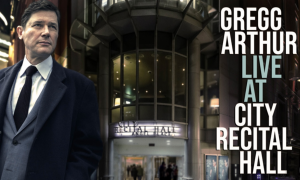
Lined and ravaged as it is, the face is ageless: as sunken as a dead man's, as softly bewildered as a child's. Chet Baker's face, and the extraordinary ways in which Bruce Weber has photographed it, encapsulate the story of Baker's life in a succession of ghostly, indelible images that are at once hauntingly beautiful and desperately sad.
Applied to a different subject, Mr. Weber's methods might seem disturbingly superficial, but they suit this portrait perfectly. The man, his music and the times in which he flourished are best served by a cinematic style that remains determinedly skin-deep.
Surfaces are everything in ”Let's Get Lost,” but they are gorgeously stylish surfaces, redolent of both contemporary notions of glamour and of the late-1950's jazz mystique of which Baker was a part. Mr. Weber, well known as a fashion photographer and as the director of one previous documentary (”Broken Noses,” in 1987), displays an unerring eye for the strikingly evocative image, using black-and-white cinematography to produce as varied a palette as other directors might achieve in color.
The result is a tremendously visceral composite representing the different stages of Baker's troubled life. It includes early glimpses of him as an uncommonly handsome young jazz trumpeter in the mid-50's, a celebrated dreamboat whose movie-star looks suggested James Dean; footage of a still-handsome Baker in the mid-60's, when his drug habit had fully taken hold and his career was beginning to decline; and terribly painful scenes shot in 1987, when Baker had grown so dissipated that old friends barely recognized him. A year later, he died after falling out of a hotel window in Amsterdam.
Interwoven with these glimpses, of course, there is music: Baker's languid voice is heard offering smoky, sinuous renditions of the romantic ballads that he favored. Mr. Weber, who adroitly mixes the sound of Baker's music with visual imagery, is most successful in conjuring a purely sensual impression of Baker's style, and of the mordant joie de vivre that colored even his deepest state of decline. Recurring shots show Baker in the back of a convertible at night, cruising in California flanked by pretty young women, the wind blowing through his hair. Only in the bright, incongruously childish eyes buried in the folds of that weathered face is there any trace of confusion and pain.
A number of Baker's friends and relatives are interviewed in ”Let's Get Lost,” most of them speaking of the man's irresistible charm, some also describing his incorrigible ways. ”He was bad, he was trouble and he was beautiful,” says one of the many women who loved him, providing the best epitaph this film has to offer. Some of Baker's children appear in the film, making it clear that their father was never a family man; various wives and girlfriends add to the general impression of irresponsiblity. Baker's own account of how he lost his teeth - supposedly after a beating involving a drug connection - is branded a self-serving lie by one of the women who knew him best.
The interview footage in ”Let's Get Lost” is less effective than some of the purely impressionistic passages, partly because Mr. Weber's questioning can be more histrionic than helpful. Interviewing Vera Baker, Chet's mother, the film maker asks whether Chet was a disappointment as a son (she says yes). At the end of the film, he asks Baker himself whether he will ”look back on this film in years to come and think of it as good times?” ”How the hell else could I see it, Bruce?” drawls the subject, with the bluntness that is one of his more appealing qualities.
Even when Mr. Weber gets a rise out of the singer Ruth Young, one of Baker's longtime girlfriends, by letting her say she controls the rights to the Baker story and then announcing that he too has been given the same rights, the director seems an unnecessary presence in his own film. He is most effective in letting the look, the sound and the tragic mystique of his subject speak elegantly and hauntingly for themselves.
Applied to a different subject, Mr. Weber's methods might seem disturbingly superficial, but they suit this portrait perfectly. The man, his music and the times in which he flourished are best served by a cinematic style that remains determinedly skin-deep.
Surfaces are everything in ”Let's Get Lost,” but they are gorgeously stylish surfaces, redolent of both contemporary notions of glamour and of the late-1950's jazz mystique of which Baker was a part. Mr. Weber, well known as a fashion photographer and as the director of one previous documentary (”Broken Noses,” in 1987), displays an unerring eye for the strikingly evocative image, using black-and-white cinematography to produce as varied a palette as other directors might achieve in color.
The result is a tremendously visceral composite representing the different stages of Baker's troubled life. It includes early glimpses of him as an uncommonly handsome young jazz trumpeter in the mid-50's, a celebrated dreamboat whose movie-star looks suggested James Dean; footage of a still-handsome Baker in the mid-60's, when his drug habit had fully taken hold and his career was beginning to decline; and terribly painful scenes shot in 1987, when Baker had grown so dissipated that old friends barely recognized him. A year later, he died after falling out of a hotel window in Amsterdam.
Interwoven with these glimpses, of course, there is music: Baker's languid voice is heard offering smoky, sinuous renditions of the romantic ballads that he favored. Mr. Weber, who adroitly mixes the sound of Baker's music with visual imagery, is most successful in conjuring a purely sensual impression of Baker's style, and of the mordant joie de vivre that colored even his deepest state of decline. Recurring shots show Baker in the back of a convertible at night, cruising in California flanked by pretty young women, the wind blowing through his hair. Only in the bright, incongruously childish eyes buried in the folds of that weathered face is there any trace of confusion and pain.
A number of Baker's friends and relatives are interviewed in ”Let's Get Lost,” most of them speaking of the man's irresistible charm, some also describing his incorrigible ways. ”He was bad, he was trouble and he was beautiful,” says one of the many women who loved him, providing the best epitaph this film has to offer. Some of Baker's children appear in the film, making it clear that their father was never a family man; various wives and girlfriends add to the general impression of irresponsiblity. Baker's own account of how he lost his teeth - supposedly after a beating involving a drug connection - is branded a self-serving lie by one of the women who knew him best.
The interview footage in ”Let's Get Lost” is less effective than some of the purely impressionistic passages, partly because Mr. Weber's questioning can be more histrionic than helpful. Interviewing Vera Baker, Chet's mother, the film maker asks whether Chet was a disappointment as a son (she says yes). At the end of the film, he asks Baker himself whether he will ”look back on this film in years to come and think of it as good times?” ”How the hell else could I see it, Bruce?” drawls the subject, with the bluntness that is one of his more appealing qualities.
Even when Mr. Weber gets a rise out of the singer Ruth Young, one of Baker's longtime girlfriends, by letting her say she controls the rights to the Baker story and then announcing that he too has been given the same rights, the director seems an unnecessary presence in his own film. He is most effective in letting the look, the sound and the tragic mystique of his subject speak elegantly and hauntingly for themselves.

































